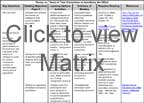Key Questions
- Why are students with physical disabilities under- represented in gifted programs?
- How can we increase the represen- tation of students with behavioral and emotional disorders in the gifted program and meet their needs in the classroom?
- How can we improve participation of learning disabled students in the gifted program and meet their unique needs in the classroom?
Gifted students with disabling conditions remain a major group of underidentified and underserved students in our schools. The focus on accommodating these students’ disabilities often precludes the recognition and development of their cognitive abilities. It is not unexpected, then, to find significant discrepancies between their potential and their actual performance in the classroom. In order for these students to reach their potential, it is imperative that their intellectual strengths be recognized and nurtured at the same time as their disability is accommodated appropriately.
Assessment
The identification of giftedness in students who are disabled is challenging. Traditional identification methods using standardized tests and observational checklists are inadequate without major modification. Standard lists of characteristics of gifted students may be misleading when looking for potential in students who have disabilities.
For example, hearing impaired students cannot respond to oral directions and may lack the vocabulary that reflects the complexity of their thoughts. Students with speech or language impairments have difficulty with tests requiring verbal responses. Those with visual impairments may not be able to do certain performance tasks required on a test, and although their vocabulary may be quite advanced, they may not understand the full meaning of the words they use (e.g., color words). Students with learning disabilities may use high-level vocabulary in speaking but may be unable to express themselves in writing, or vice versa. Limited life experiences due to physical impairments may result in lower test scores. Since the population of gifted/disabled students is difficult to locate, they seldom are included in standardized test norming groups, adding to the problems of comparison.
In addition, gifted students with disabilities often use their intelligence to try to hide their disability. This may cause both exceptionalities to appear less extreme; the disability may appear less severe because the students are using their intellect to cope, while the efforts expended in that area may hinder other expressions of giftedness. Some of the emotional intensity that may be seen as an emotional disorder may be due to giftedness itself. There’s that old saying, “the fine line between insanity and genius.” While that certainly doesn’t suggest that gifted students are all on the brink of emotional disaster, it does suggest that educators pay as much attention to the emotional aspects of the gifted student as they do to the academic and cognitive aspects of the student.
In the article Misdiagnosis and Dual Diagnoses of Gifted Children, author James T. Webb provides several examples of commonly misdiagnosed groups of gifted children. It takes a well-trained teacher to recognize these bright and creative children. As you read this article, think about how you can use this information to identify children who exhibit a possible dual diagnosis and how you can share this information with the administration, school psychologists, and parents.

